| Back to Back Issues Page |
 |
|
Bangkok Travelbug May 12 Prasat Pueai Noi – Khon Kaen's Khmer sanctuary April 27, 2012 |
| Hello
Amphur Pueai Noi Amphur Pueai Noi is a district 80 km south of Khon Kaen city. It’s a sparsely populated area compared to Amphur Chonnabot, the other district we visited earlier. Houses are few and far between and the place we were going to is at the border with Maha Sarakham. Table of contents The Khmer heritage The Khmer sanctuaries in Thailand are a legacy of the Angkor Empire which existed between 9th – 14th centuries AD. In 802 AD King Jayavaman II started the empire that would become a major influence in the region for the next five centuries. It was in 1113 that King Suryavaman II built a grand city dedicated to Vishnu. This city called Angkor Wat, the Temple City or Nakhon Wat in Thai, became an architectural and cultural heritage for the world today. The influence of this empire extended northwards and westwards into present-day north-eastern Thailand. Pilgrims and travellers crossed the Dongrak Mountains separating present-day Cambodia and Thailand along what became known as the Cultural Route. Temples and sanctuaries were built along this route for pilgrims seeking rest and meditation. Surin just north of Cambodia has eleven of these Khmer sanctuaries. Neighbouring Buriram has five of which Prasat Hin Phanom Rung is the best known. Nakhon Ratchasima (Korat) has Prasat Hin Phimai. In the remote district of Pueai Noi, Khon Kaen stand the remains of what was the biggest Khmer sanctuary in north-eastern Thailand, Prasat Pueai Noi. 
Prasat Pueai Noi, Amphur Pueai Noi, Khon Kaen Table of contents Prasat Pueai Noi Prasat Pueai Noi, also called Ku Pueai Noi, was built in between the 11th - 12th century AD and fashioned after Angkor Wat. Reputedly the largest Khmer sanctuary in the upper north-east region what remains today unfortunately is a shadow of its former structure. 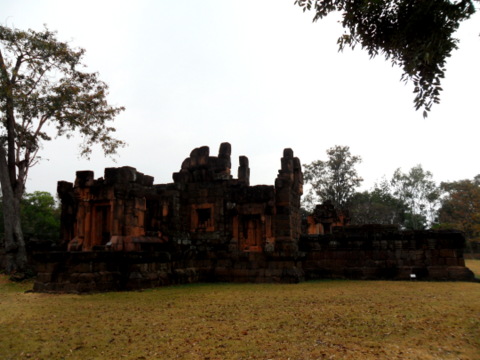
The Khmer sanctuary in Khon Kaen The architecture in Khmer sanctuaries is characterised by a grand entrance consisting of a causeway over a moat with Naga serpents lining the sides of the causeway, the link between Heaven and Earth. This however is missing in the Prasat Pueai Noi ruins. Part of an outer wall still remains and perhaps that was where the moat was. 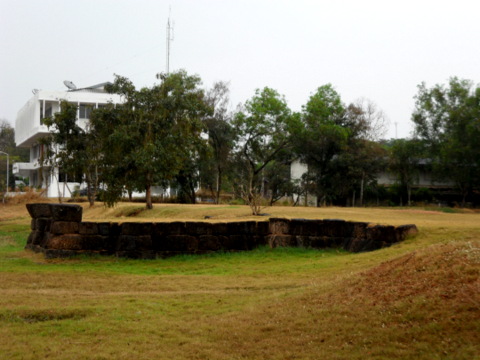
All that remains of the outer wall The ruins of Prasat Pueai Noi are actually very small compared to the other Khmer sanctuaries like Prasat Hin Phanom Rung or even Prasat Hin Phimai. We can only see one ring of walls, the aligned doorways at the entrance and some of the elaborately carved lintels over doorways and arches. Please see the satellite map of Prasart Pueai Noi for a 3 D plan view of the Khmer sanctuary. The wall surrounding the sanctuary, the east and west entrances and the three buildings within the walls are clearly visible. View Prasat Pueai Noi in a larger map Let’s take a virtual tour of this Khmer sanctuary. 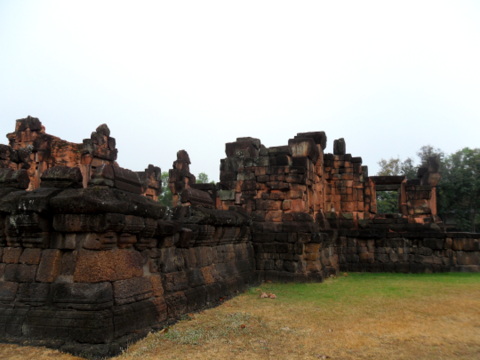
The existing wall to the sanctuary The concentric rings of walls are missing. The entrances to Prasat Pueai Noi are at the east and west walls. 
The east entrance If you look closely at the satellite picture, the entrance is in the form of a cross; a series of doorways leading into the sanctuary and a row of rooms perpendicular to the doorways. 
Multiple doors at the east entrance Pilgrims from the far reaches of the empire have taken that long journey on the Cultural Route to pass through these portals to enter the inner sanctuary for prayer and meditation. Take a look at the map of Prasat Hin Phimai and switch to the satellite version and you can see the same features at the entrances, the structure is in the form of a cross. 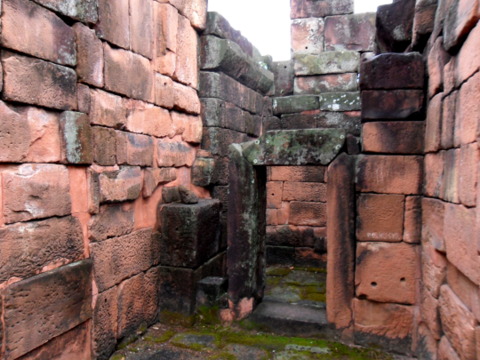
The space to the left and right of the doorways There are three buildings within the walls. 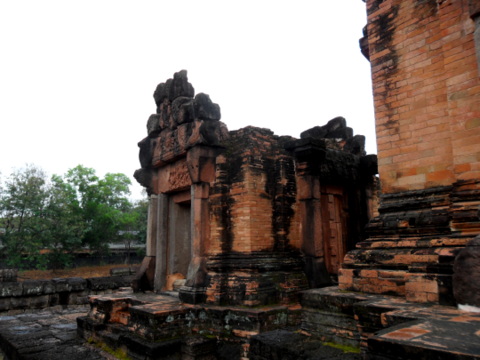
One of the three buildings inside the sanctuary People have been praying and making offerings inside these buildings. 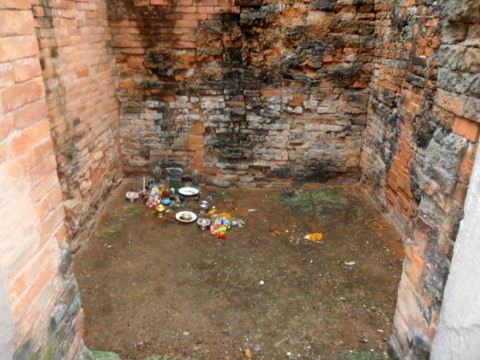
Inside the building Besides the three buildings inside, there’s also this structure that is to the left of the east entrance. 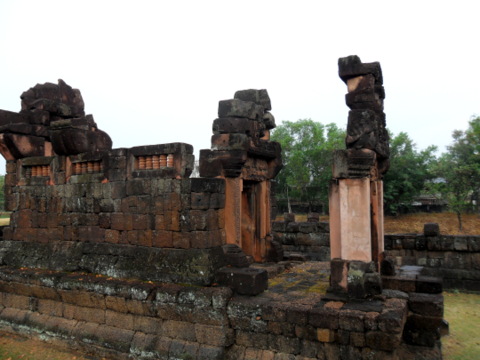
Structure next to the east entrance The lawn within the walls looks well-kept. Perhaps more signboards explaining the different structures would be helpful. 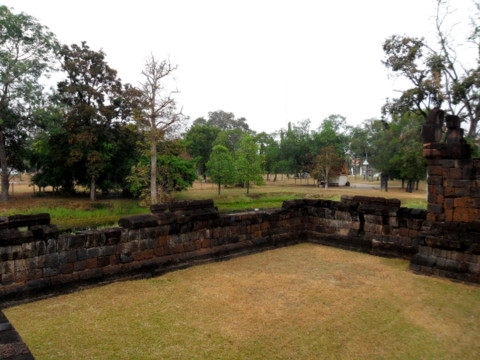
Inside the walled enclosure Khmer sanctuaries are noted for their elaborately carved lintels above the doorways and by the sides. 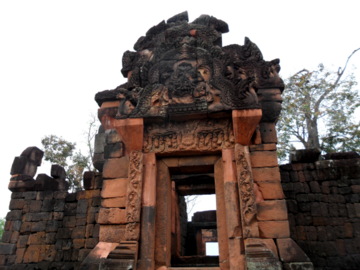

Carvings at the doorways I visited Prasat Pueai Noi on my last day in Khon Kaen, the day before I left for Bangkok. It was so different from the other places in Khon Kaen I had visited earlier. At the other places, there were pictures, displays, models, music and people, there was life. 
The west entrance At Prasat Pueai Noi, there were only dark silent walls starring back at me in the light afternoon drizzle. Yet these walls seemed to tell a story, the story that dates back a thousand years. As the empire crumbled and finally collapsed what of the uncertainty within these walls? Did the pilgrims continue to come or did their number dwindle, as these sanctuaries suffered the same fate as the empire? 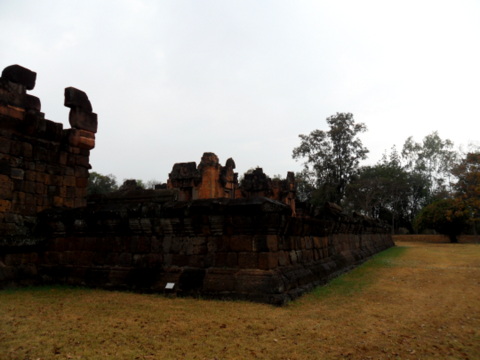
Table of contents Map to Amphur Pueai Noi View Map to Prasart Pueai Noi in a larger map Getting to Khon Kaen city If you are going to Khon Kaen city first, please see map and directions given in map of Khon Kaen in the February 12 issue. Getting to Amphur Pueai Noi If you are coming from Khon Kaen city drive south along Highway 2 to the Ban Phai intersection and turn left to Highway 23. Drive on till you reach Tambon Hin Tang and turn right to Highway 2301. Then turn left to Highway 2297. Continue on till you reach Prasat Pueai Noi. Table of contents My thanks I wish to express my sincere thanks to the people of Amphur Pueai Noi who helped us along the way to find the sanctuary, my sincere appreciation and a big thank you for your helpfulness. Where to stay – hotels in Khon Kaen Please see hotels in Khon Kaen for the hotels in the city area. Here are some of the reasonably priced hotels with walking distance of the Khon Kaen Bus Terminal. Bussarakam Hotel Kaen Inn Hotel Kaen Nakhon Hotel Piman Garden Hotel Table of contents Next month This is the last of the four articles on Khon Kaen. Next month we will be exploring Samut Songkhram. 

If you enjoyed reading this e-zine, please forward it to a friend. If you received this from a friend and found it interesting, please subscribe at Bangkok Travelbug. What you think of the Bangkok Travelbug? We love to hear from you What other subscribers have said Till next month then. Eric Lim Find us on Facebook Stay updated with what’s new at Tour Bangkok Legacies. Copy the link below and paste it into your Google Reader, NetNewsWire or your favorite feed reader. https://www.tour-bangkok-legacies.com/tour-Bangkok-legacies.xml If you use My Yahoo! or My MSN, head over to my home page and click on the button for your favourite Web-based feed reader. Visit our home page at Tour Bangkok Legacies. Copyright@2008-2012 Tour Bangkok Legacies All rights reserved |
| Back to Back Issues Page |